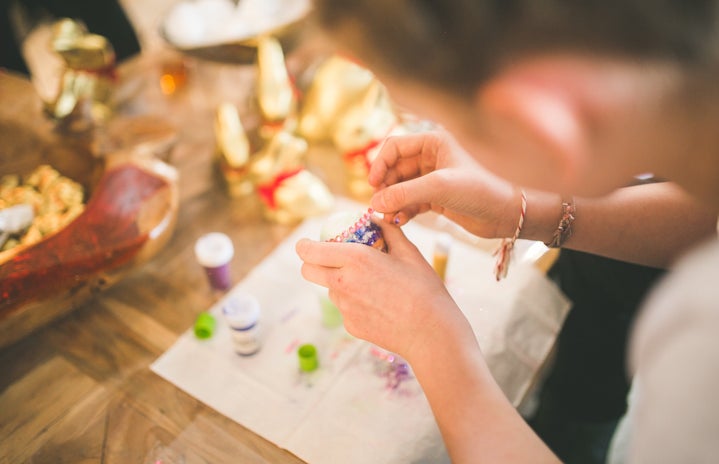To start with a little backstory on my piercings: I’ve had my industrial, anti-helix, cartilage, and lobes pierced for a while now. They were all done professionally and I never really took my earrings out or messed with them too much; so, everything was always well maintained. Until I moved to State College, that is. I’m not quite sure if it was showering with the hard water in the dorms, sleeping on my boyfriend’s pillows, or just all the sweat from walking to classes, but my earrings on my left ear ALL got infected at the same time – for the first time.
Naturally, I took everything out, cleaned my ear and the jewelry as best I could, and decided to spend the night without any earrings in. This seemed like a good idea and did, in fact, help my ear out tremendously. However, the next morning my ear was still too swollen to get anything back in. So, I waited another day and night. This wasn’t the best move, I came to realize as the cartilage piercings (industrial, and anti-helix) scabbed over and closed over the two-day period. Not knowing what to do, I decided that my industrial piercing was healed enough for me to try to get the blunt bar back through – a huge mistake. I ended up causing my ear to bleed and just made the ear start to hurt again.
Back from the drawing board with a new plan, I came to the conclusion that I wasn’t going to pay a professional $50 – $60 to re-pierce my ear. I was going to do it myself (even though piercing is a professional job for a reason I would soon realize). That’s when I made the walk to McLanahan’s, a small grocery store downtown, and bought the essentials: a thick sewing needle (that I sterilized with a flame), Bactine, and saline solution.
Fast-forward: Picture a small blonde girl with a needle through one side of her cartilage with blood pouring down the side of her face, that blonde hair now a little pink. At that moment I was not proud to be said girl. I had managed to find the spots where the piercing was before, or at least got close enough to it, and braced myself for the final pull of the needle through the other side of my ear, lacking the strength and leverage to do it quickly. So, there I stood just kind of slowly pushing harder and harder until I heard the worst POP and felt the pressure release as the needle slid through my ear. Now I had holes again, but still had do figure out how to slide a 14-gauge barbell through the tiny sewing needle hole. To remedy this, I ended up pulling the needle all the way through so even the thicker part where you put thread through the end of the needle went through. I seriously thought I was going to faint after doing that to the second side of my cartilage, there was so much blood and my ear was bruising already. I stuck in there though and grabbed the barbell and quickly pushed it through before any of the blood had time to dry and make my job harder. Luckily, I got it in on the first attempt and screwed the jewelry in place. Now all that was left to do was clean it thoroughly, shower, and take some pain medication.
You see, through this experience I learned that piercings are not as simple as putting a needle through your ear, especially depending on the shape of your ear and location of the piercing. There is a reason professionals use needles attached to the jewelry, and there is a reason they do it for you where they can have a good vantage point (unlike your own bathroom mirror). There are so many risks for infection – and even shattering the cartilage of your ear – that are present that, truthfully, it was bold of me to risk. In retrospect, I wouldn’t recommend that anyone try this. Thankfully, after cleaning up and taking medication for the swelling, my ear turned out fine and actually the infection went away. My anti-helix is still healing and I luckily didn’t attempt to put a needle trough it because it may actually require antibiotics at the rate it is healing. All in all, I will definitely be going to a professional for all future piercings and to re-pierce my anti-helix once it is healed. Don’t try this at home, friends!



